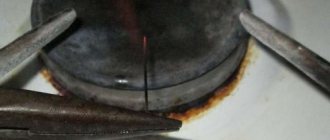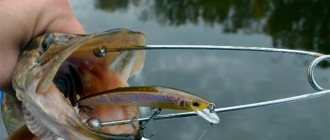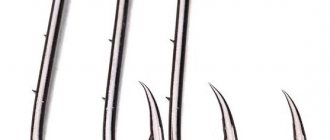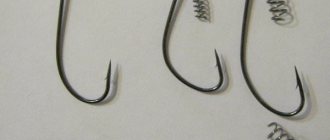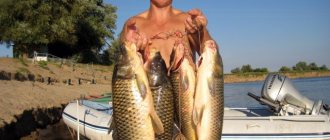Types of hooks
On sale today you can find a large number of these gears, which will differ from each other in size, shape, color, material of manufacture, and functions. The last point remains unclear to most amateur fishermen, but everything here is quite simple.
Each hook is designed for a specific type of fishing:
- It is not advisable to catch trophy specimens on a hook with a large shank, as they will be scared and will not take the bait
Fishing with live bait;
- For making a wobbler;
- To catch trophy species;
- Hooks for fly fishing.
Each product has one or more undershirts, so there is also a certain classification here:
- Single;
- Double;
- Triple;
- Blueberries;
- Fivers.
However, the last two types are quite problematic to find, since they are not particularly popular due to their low efficiency. According to their purpose, hooks also come in the following types:
- Catfish;
- Cyprinidae;
- Wobblins;
- Fly fishing.
The line is secured to the hooks using a special spatula or eyelet, and products with an eyelet began to be produced not too long ago - about a hundred years ago; before that, fishermen used hooks exclusively with a spatula.
The hooks on the fore-end have special barbs that make it possible to strengthen the fixation of biting fish, but such products should not be abused. In particular, it is not advisable to catch trophy specimens on a hook with a large shank, as they will be scared and will not take the bait.
It is very important to pay attention to the material from which such gear is made. In most cases, they are made from ordinary hardened steel. However, they are quite sensitive to the occurrence of corrosion processes. As a result, they last literally for one season, after which they become covered with a thick layer of rust and become fragile. Stainless steel gear is much more reliable and durable.
Types of Fishing Hooks
Next we want to talk about the types of fish hooks. All those that are currently on sale are divided into several types, namely:
Single hook. It is the most popular among all others. It has one point and an eye, to which it is customary to attach the fishing line.
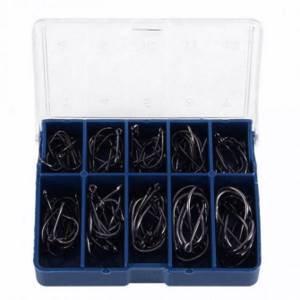
Double fishing hook. Please note that it is based on several stings. They are connected to each other and have one common ear. Their immediate purpose is jig fishing.
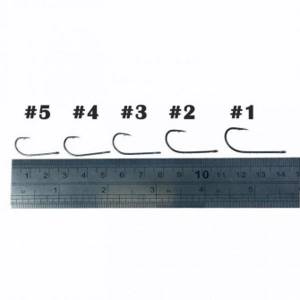
Tee (treble hook). The tee is most popular among fans of spinning rods. It is the tee that is now equipped with all the most modern spinning rods.
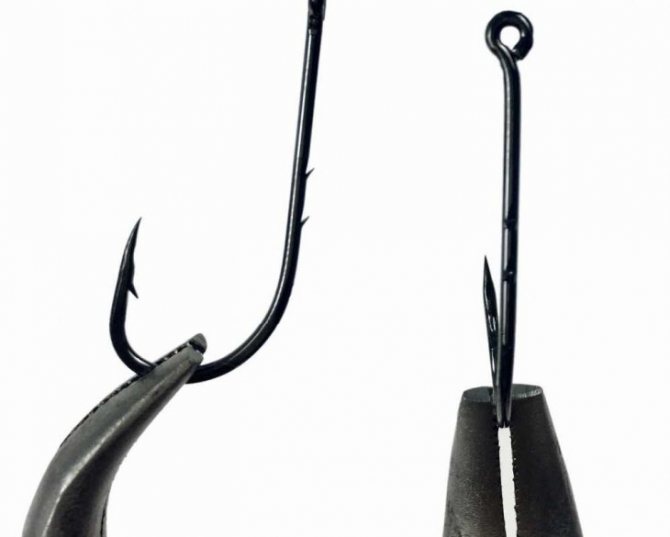
You also need to know that hooks are differentiated by their shape, color and weight.
Dimensions
When choosing a fishing hook, it is advisable to adopt the principle of numbering this element of gear. In our country, numbering from 2.5 to 16 mm has been in effect for several decades. Hooks with fractional sizes, for example, 2.5 or 4.5 mm, were also marked up to 9 mm.
All other products were numbered in the form of integers, and this indicator indicated the distance at which the forearm and sting were removed from each other. Not too long ago, an international classification was developed.
It is called the Reddic scale:
| International numbering | Russian numbering | Hook width in millimeters | |
| international | Russian | ||
| 24 | – | 1,7 | – |
| 22 | – | 2 | – |
| 20 | – | 2,2 | – |
| 19 | – | 2,4 | – |
| 18 | 2,5 | 2,6 | 2,5 |
| 17 | 3 | 3 | 3 |
| 16 | – | 3,2 | – |
| 15 | 3,5 | 3,4 | 3,5 |
| 14 | – | 3,6 | – |
| 13 | 4 | 4 | 4 |
| 12 | – | 4,4 | – |
| 11 | 4,5 | 4,6 | 4,5 |
| 10 | 5 | 5 | 5 |
| 9 | – | 5,5 | – |
| 8 | 6 | 6 | 6 |
| 7 | – | 6,5 | – |
| 6 | 7 | 7 | 7 |
| 5 | – | 7,5 | – |
| 4 | 8 | 8 | 8 |
| 3 | – | 8,5 | – |
| 2 | – | 9 | – |
| 1 | 10 | 10 | 10 |
| 1/0 | 12 | 12 | 12 |
| 2/0 | 14 | 14 | 14 |
| 3/0 | 16 | 16 | 16 |
Photo of hook numbering
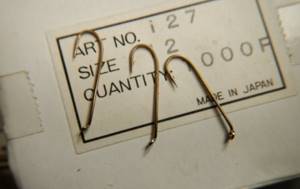
Note!
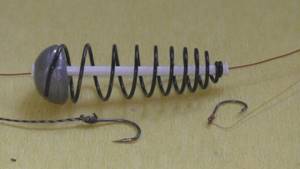
Fishing with a spring - rigs, baits, baits, gear and methods of fishing with a spring (80 photos)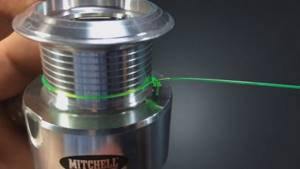
How to tie a fishing line to a reel - methods, tips on how to tie correctly and an overview of the most reliable knots (85 photos and videos)
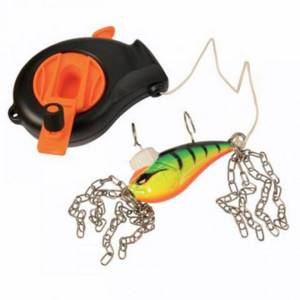
Cuts for wobblers and spinners - how to make a simple homemade cut. 110 photos and videos of practical tips
Read here How to make a zakidushka with your own hands - a step-by-step description of production from the masters (125 photos and videos)
Help the project, share on social networks 

0
Determining the size
Every novice angler should be well versed in the gradation of this element of gear. The package with the hook must contain encrypted information regarding all the data that will be needed in order to make an informed choice. This is a set of alphabetic and numeric characters. If you know what each of them will mean, then you can easily determine how long the hook is, how thick its shank and width are.
It was experimentally determined that the most universal are numbers 5 and 6
The marking begins with Roman numerals, which indicate the following information:
- I – single hook, equipped with a spatula and having a single bend;
- II – single, having a spatula and a single bend;
- III – single, the fishing line on which is attached through a spatula and has a double bend;
- IV – single, having a ring and a double bend.
The next number indicates the width of the hook in millimeters. The last numerical value indicates how long the forend is.
It is worth noting that stores selling fishing gear have in their assortment not only domestic, but also imported products. Their quality is directly dependent on which company manufactured the equipment.
In the domestic numbering of hooks, the smallest one is the one numbered 2.5. Amateur fishermen nicknamed it “swallow”. Its size is small, and it looks quite elegant. Suitable for fish with a small mouth, usually used for flies, maggots and other small baits.
To catch fish of larger sizes, as well as for experimenting with baits, you can use hooks with numbers 3 and 4. However, it was experimentally determined that numbers 5 and 6 are the most universal.
You can catch perch, small pike, carp, large crucian carp, bream and so on. For trophy specimens, even larger products will be needed - carp, grass carp and other large species are already caught with them. Catfish will require the use of only large hooks - the largest that can be found on sale.
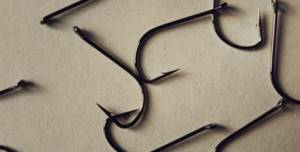
Hooks for sport fishing
For those involved in sport fishing, we advise you to purchase similar hooks in stores. They differ from all others in their strength, immunity to corrosion, and efficiency.
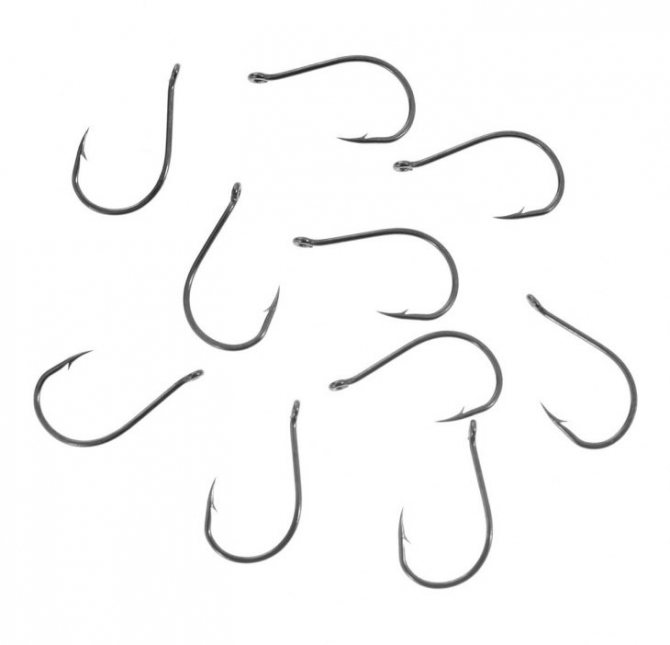
Sports hooks are usually made of several alloys.

Specific choice
To catch wary fish, you can try using hooks of different colors, but at the same time they are taken to match the color of the bait
Small fish do not bite too often, but in most cases the bites are quite sharp and short-lived, when they have time to not only swallow the bait very deeply, but also spit it out, as a result of which the float sharply goes under the water, and then returns to its original position again .
In this regard, for species such as rudd, roach, bleak, and sometimes white bream, it is best to use hooks with an extended shank and a side bend. The last element of the design is designed to prevent the fish from jumping off after a bite, and they are also quite easy to pull out of the fish’s mouth.
You need to catch small fish quickly, as the school moves from one place to another. Hooks numbered 14 and 18 are suitable here.
If the fish bite is not too active or is not observed at all, then it is best to put a smaller hook on the tackle so that it is not too noticeable. In addition, the fish are in most cases very cautious, so the hook should be camouflaged with bait. Select a hook whose shank will be minimal and light in weight.
In principle, to catch cautious fish, you can try using hooks of different colors, but at the same time they are taken to match the color of the bait. If the fish is large, then the bait on the hook should also be larger. They also take a large hook, which has an increased bend of the tip and a rather short fore-end.
With the help of this tackle, the fish will sit tighter and stay on it well. In this regard, for fish such as ide, bream, chub or large carp, you should try to catch them on hooks with numbers from 10 to 16.
When going after a powerful fish, quite serious loads are created on both the hook and the fishing line along with the rod. Therefore, it is necessary to select large products made of thick wire. In principle, in this case there are no special requirements for the shape of the hook, the main thing is that the level of its strength is as high as possible.
Chinese hook numbering
Now we want to talk about the numbering of Chinese fish hooks. Compared to Japanese numbering, things are a little different in China.
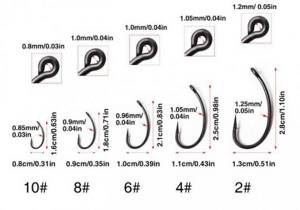
The first number always indicates the number of hooks, the next number indicates the hook itself, namely what it is made of and who the manufacturer is.
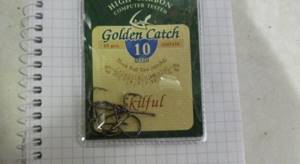
Blitz tips
- When purchasing a fishing hook, you should not give preference to too cheap products. They are capable of breaking or bending under the influence of the mass or play of the fish, as a result, it will simply jump off it and go into the depths. Cheap hooks are often blunt, which allows the fish not to bite on it, but simply eat the bait;
- Even an experienced fisherman is unable to select a reliable hook by eye that will catch big fish. Moreover, there are a large number of different models on sale. Usually experienced fishermen take the most catchy hooks with them to the store and begin to select such gear according to their image and likeness;
- Today, there is no consensus among fishermen about which way is better to attach the hook to the fishing line - through an eye or a spatula. However, recently they are starting to return to the spatula again, since a competent knot made on it will be much more reliable. In addition, there may be a sharp edge under the ring, which, if caught, can cut the fishing line and simply lose the hook. In the case of a spatula, a similar effect is not observed;
- If the fisherman does not intend to catch large fish, then it is best to take the thinnest hook. It does not weigh too much and allows you to use even quite delicate baits such as bloodworms without breaking it, since no fish will bite on such a bait - it will immediately become clear to it that they are slipping something that is not entirely necessary for it.
How to attach a hook?
Improper fastening can lead to imbalance of the gear and reduce its catchability due to limited maneuverability. There are many known ways of tying knots to attach a hook to a fishing line; when choosing from them, the main indicator is to ensure that there is no slipping. In addition, the selected unit must be able to withstand the weight of the catch. The most common types of fastening to a fishing line include fishing and Canadian eights, as well as a universal type of knot. Conclusion
The correct choice of hook affects the number of fish caught. There are many different designs that have comparative advantages within a specified, narrow range of conditions. At the same time, there are optimal design options, the use of which shows high efficiency when used in almost any conditions.
Content
- 1. What is a fishing hook
- 2. What parts does a fishing hook consist of?
- 2.1 Fishing hook head and its function
- 2.2 Fishing hook forearm and its purpose
- 2.3 Prying a fishing hook
- 2.4 Fish hook tip
- 2.5 Function of the beard
- 5.1 Separation of hooks by type
- 5.2 Separation of hooks by fish species
- 5.3 Separation of hooks according to fishing conditions
- 6.1 How to correctly read sizing information on packaging
International
The name international was appropriated by the enterprising British. Their classification is also called the “Reddish scale” after the name of the city of Redditch, in which the factory for the production of fishing accessories, and in particular fishing hooks, was located. It is unknown what guided the founders of the company when they adopted this size scale, but it is now the most important in the world.
The peculiarity of this numbering is that the smallest hook in it has the largest numerical value, number 24, and vice versa, the first number is the largest hook, corresponding to our 10.
Larger hooks, which in particular are offset hooks, are numbered with two numbers, for example 2/0.

